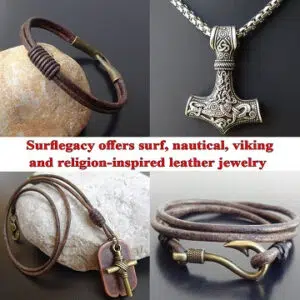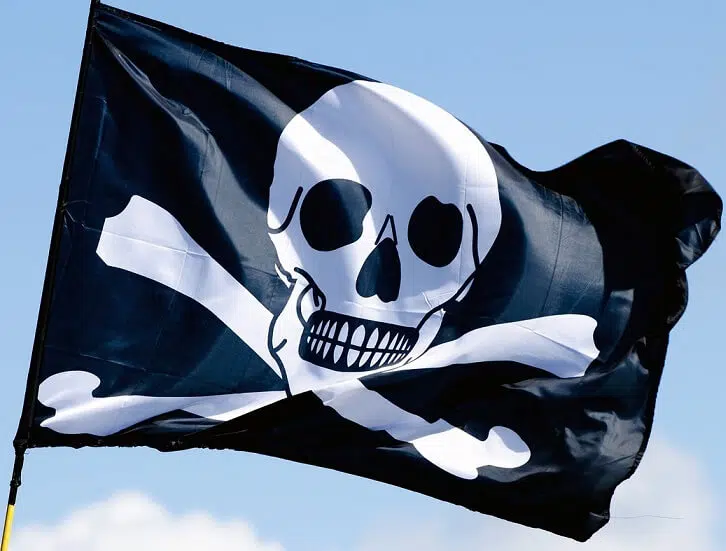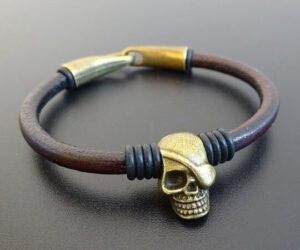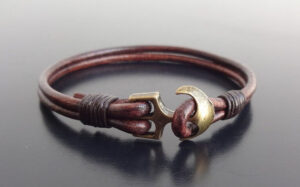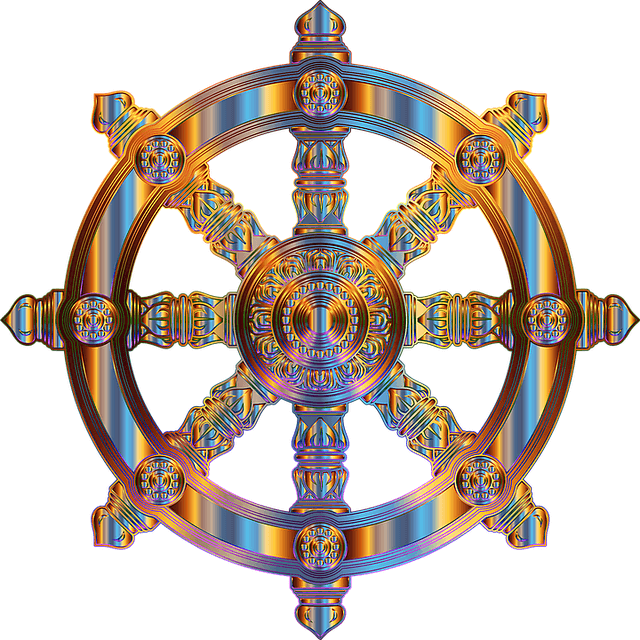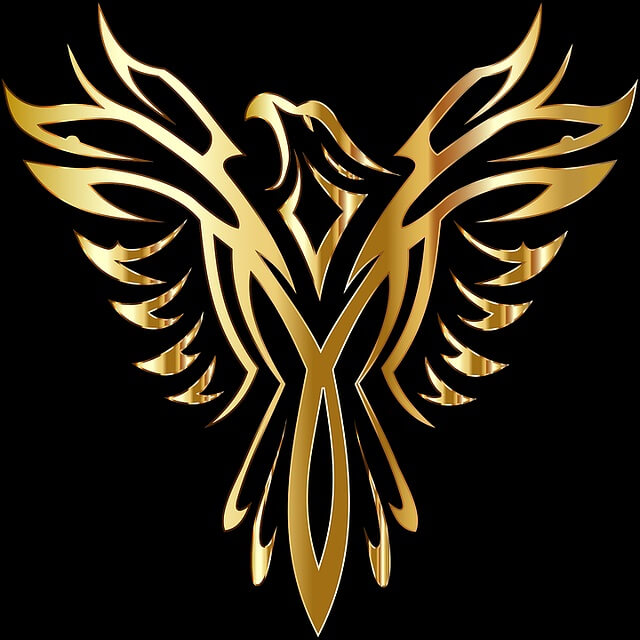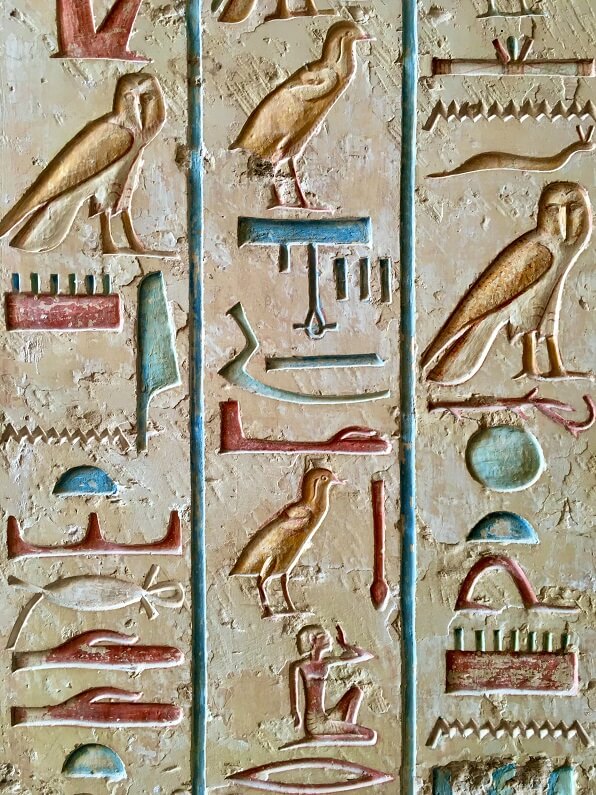Ahoy, mateys! Set sail on a thrilling voyage as we delve into the captivating world of pirate symbols. For centuries, pirates have fascinated us with their daring escapades, buried treasures, and enigmatic way of life.
But it’s not just their adventures that have held us under their spell; it’s the symbols they left behind.
In this blog post, we embark on a quest to uncover the meanings behind the seven most popular pirate symbols. These timeless emblems have become synonymous with the allure of the high seas and the lawless realm of pirates.
From the iconic Jolly Roger flag, with its ominous skull and crossbones, to the ominous black flag that struck fear into the hearts of their victims, each symbol carries its own story and significance.
So, whether you’re a history enthusiast, a lover of all things pirate, or simply intrigued by the mystery surrounding these symbols, join us as we unravel the secrets behind these intriguing marks of piracy.
Get ready to hoist the anchor and set sail into the realm of pirate symbolism!
The Fascination with Pirate Symbols
Pirates have long captured the imagination and held a special place in popular culture and media. From classic literature like Robert Louis Stevenson’s “Treasure Island” to blockbuster films such as the “Pirates of the Caribbean” franchise, these seafaring outlaws have become beloved figures that continue to captivate audiences.
Pirates embody a sense of adventure, rebellion, and freedom that resonates with people of all ages. Their tales of plundering ships, searching for hidden treasures, and defying authority have been immortalized through various forms of entertainment. Their charismatic personalities, swashbuckling exploits, and distinctive style have made them enduring icons.
Pirate symbols play a crucial role in adding to the mystique and intrigue surrounding pirates. These symbols serve as visual representations of their lawless existence, instilling a sense of fear and fascination. Whether displayed on flags, tattoos, or other forms of pirate regalia, these symbols serve as a warning to their adversaries while embodying the pirate’s unique identity.
These captivating symbols not only differentiate pirates from other seafarers but also establish their distinct brand. They create a visual language that communicates their values, reputation, and intentions. The use of symbols helps build the aura of mystery and adventure associated with pirates, making them an integral part of their legend.
7 Most Popular Pirate Symbols and Their Meanings
1. The Jolly Roger
The Jolly Roger, a name derived from the French term “jolie rouge” meaning “pretty red,” stands tall as the most recognizable emblem of piracy. Its origins can be traced back to the early 18th century when pirates began adopting distinctive flags to strike fear into the hearts of their targets.
The Jolly Roger became the symbol of choice, with its menacing design and ominous aura.
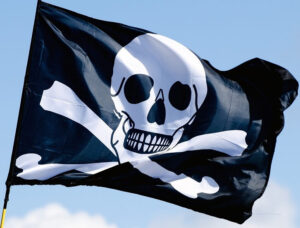
Various versions of pirate flags existed throughout history. For instance, Calico Jack Rackham and Thomas Tew used a variant featuring two crossed swords instead of bones.
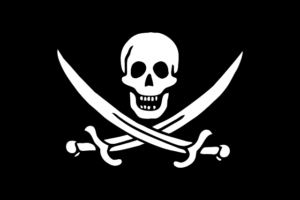
Edward Teach, famously known as “Blackbeard,” flew a flag with a skeleton holding an hourglass in one hand and either a sword or an arrow in the other, accompanied by a bleeding heart.
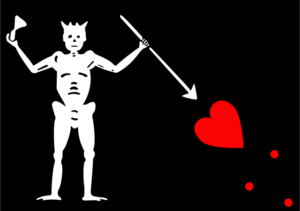
Bartholomew Roberts, also known as Black Bart, had two variations of his flag: one depicted a man and a skeleton, with the skeleton holding a sword or an arrow in one hand and an hourglass or a cup in the other, symbolizing a toast to death.
The other variation displayed an armed man standing on two skulls above the letters ABH and AMH, serving as a warning to the inhabitants of Barbados and Martinique that death awaited them.
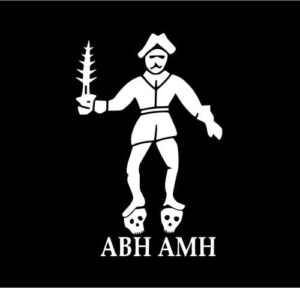
One notable variation was the “Bloody Red” flag, featuring a red color field alongside the black. This symbolized the pirates’ intent to show no mercy and their willingness to shed blood during raids. Another variation was the “Plain Black” flag, devoid of any additional symbols, which represented a more straightforward and uncompromising approach to piracy.
These variations allowed pirates to express their unique identities and instill fear through distinctive visual cues.
The black flag, in all its iterations, became a chilling symbol of the pirate’s unyielding pursuit of fortune, power, and freedom on the high seas.
The presence of dancing skeletons on the flags symbolized the pirates’ indifference towards their own mortality.
The skull and crossbones motif, prominently displayed on the Jolly Roger, carries deep symbolic meaning. The skull represents death, reminding all who encountered it that pirates were ruthless and dangerous adversaries.
The crossed bones beneath the skull often symbolize mortality and the fragility of life, further emphasizing the pirates’ willingness to take lives if provoked.
Beyond its literal representation, the skull and crossbones motif served as a psychological weapon, striking fear into the hearts of potential victims. It was a visual declaration of the pirates’ readiness to engage in battle and their utter disregard for societal norms.
The symbol embodied the pirate’s defiance against authority and their unwavering commitment to a life outside the confines of the law.
The Jolly Roger, with its skull and crossbones, became synonymous with piracy itself. Its menacing presence on the high seas announced the arrival of danger, plunder, and lawlessness.
Even today, the Jolly Roger continues to evoke a sense of adventure and rebellion, reminding us of the enduring legacy of pirate symbols.
2. Corsair Ships
Corsair ships, also known as privateer vessels, were formidable and daring ships that played a significant role in the Golden Age of Piracy.
These agile and fast-sailing vessels were specifically designed for raiding and plundering enemy ships, making them essential tools for corsairs—the licensed pirates sanctioned by governments to target enemy vessels during times of war.
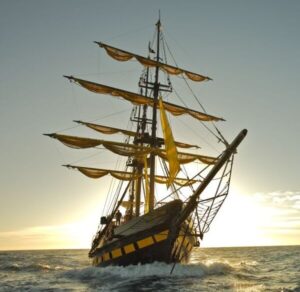
Corsair ships were known for their speed and maneuverability, enabling them to swiftly pursue and overtake their targets. These vessels were often armed with cannons and equipped with an experienced crew skilled in naval warfare.
Their sleek design allowed them to navigate shallow waters, giving corsairs an advantage in evading larger warships or escaping pursuit.
These ships became symbols of fear and intimidation on the high seas. The sight of a corsair ship approaching struck fear into the hearts of their victims, as they knew the vessel carried a crew of ruthless and determined pirates ready to seize their cargo and valuables.
Corsair ships embodied the audacity and daring nature of piracy, instilling a sense of dread among merchant ships and coastal settlements alike.
The legacy of corsair ships can still be seen today in various forms, from historical accounts and artistic depictions to maritime museums. Their iconic status as symbols of piracy serves as a reminder of the bold exploits and adventurous spirit of the corsairs who once ruled the seas.
These ships, as pirate symbols, continue to evoke a sense of awe and fascination, reminding us of the thrilling era of pirates and their fearless pursuits on the open ocean.
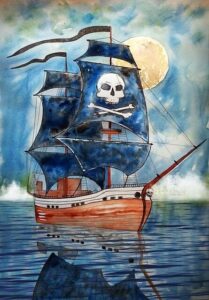
Examples of Notable Pirate Ship Symbols and Their Meanings
- The Queen Anne’s Revenge: The flagship of the infamous pirate Blackbeard, this ship symbolized his reign of terror. It struck fear into the hearts of all who encountered it, serving as a symbol of his power and ruthlessness.
- The Flying Dutchman: A legendary ghost ship, the Flying Dutchman symbolized eternal damnation and ill-fated journeys. It represented the restless spirit of a cursed captain and his doomed crew, forever condemned to sail the seas.
- The Fancy: Captained by Henry Avery, the Fancy represented audacity and success. It symbolized the pirate’s ability to transform from a lowly privateer to a feared buccaneer, achieving immense wealth and notoriety.
These examples showcase the diverse meanings associated with pirate symbols. Each symbolizes the unique stories, exploits, and legacies of the pirates who commanded them.
Pirate ship symbols, with their grandeur and mystique, continue to capture our imaginations, reminding us of a bygone era filled with swashbuckling adventures and seafaring rogues.
3. Cutlass Sword
The cutlass sword, a prominent weapon synonymous with pirate symbols, holds a storied place in the annals of piracy. This uniquely designed blade features a curved, single-edged construction, rendering it a formidable and versatile weapon in close-quarters combat.

The cutlass became the weapon of choice for many pirates during the Golden Age of Piracy, renowned for its ease of use and effectiveness in the unpredictable and frenzied battles that unfolded on the decks of pirate ships.
With its distinctive silhouette and association with pirate lore, the cutlass sword became an iconic symbol of the pirate’s way of life. Its inclusion among pirate symbols evokes images of swashbuckling adventurers engaging in thrilling duels and boarding enemy vessels. The cutlass represented both the might and agility of pirates, reflecting their readiness for combat and their penchant for unrelenting action.
The cutlass sword’s design played a crucial role in its effectiveness as a pirate weapon. Its slightly curved blade allowed for more forceful slashing motions, while the single edge facilitated swift and precise strikes.
Additionally, the handguard provided protection and prevented adversaries’ blades from sliding down and injuring the pirate wielding it. This combination of attributes made the cutlass an ideal weapon for the close-quarter melee battles common in pirate raids.
In the realm of pirate symbols, the cutlass sword embodies the daring spirit and fierce determination of those who embraced the pirate lifestyle. It symbolizes their readiness to face adversity, their skill in combat, and their relentless pursuit of wealth and adventure.
The cutlass sword’s inclusion in pirate iconography reflects the enduring fascination with piracy, invoking images of pirates brandishing their swords as they fought for their lives and their share of the plunder.
Today, the cutlass sword continues to captivate imaginations and serves as a reminder of the swashbuckling tales that have permeated popular culture. Its silhouette adorns flags, logos, and various pirate-themed merchandise, reinforcing its status as one of the enduring symbols of piracy.
The cutlass sword, with its rich history and iconic design, remains an emblematic representation of the bold and daring spirit that defines the world of pirates.
Beyond weapons, other tools used by pirates held their own symbolic meanings.
The compass represented navigation and the pirates’ ability to find their way amidst uncharted waters. It symbolized their freedom to explore new territories and discover hidden treasures.
The spyglass, a telescopic instrument, represented the pirates’ keen observation skills, enabling them to spot potential targets or dangers from afar. It symbolized their resourcefulness and adaptability, traits essential to survival in their perilous trade.
Additionally, tools such as grappling hooks, ropes, and maps symbolized the practical aspects of piracy. Grappling hooks and ropes represented the pirates’ ability to board and conquer enemy vessels, showcasing their physical prowess and tenacity.
Maps, often marked with secret locations or buried treasure, symbolized the allure of the unknown and the promise of unimaginable riches.
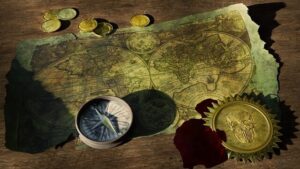
These weapons and tools, with their symbolism and practicality, embodied the essence of piracy—aggression, dominance, resourcefulness, and the unyielding pursuit of wealth and adventure.
They remain enduring symbols of the pirate’s way of life and continue to capture our fascination with their tales of daring escapades on the high seas.
4. Hourglass
The hourglass, one of the most powerful symbols originally present on the pirate flag, carried a dual meaning for those who encountered it. It conveyed the message, “Your time is running out,” as well as “You have little time to surrender.”
It forced individuals into a corner and simultaneously instilled a reverential fear associated with the symbol of Time inexorably ticking away, without the possibility of cyclicality suggested, for example, by a clock. The hourglass, along with the rest of the pirate iconography, holds a deeper significance in defining the very essence of being a pirate.
When you embark on a pirate ship, you willingly accept a death sentence. You know that your time is limited, akin to the sand in an hourglass, and that you will sail with Death as your constant companion. The pirate symbols remind every soul aboard that their existence is on borrowed time, and they navigate the high seas with a solemn awareness of mortality.

Jolly Roger flag of pirate captain Napin
5. Anchor
Among the array of pirate symbols, the anchor stands as a steadfast emblem of stability and resilience. In the treacherous waters of the high seas, pirates relied on anchors to secure their ships, allowing them to weather storms and maintain their footing amidst turbulent tides.
The anchor’s significance extends beyond its practical function, becoming a potent symbol of strength, determination, and unwavering resolve. With its iconic shape and weighty presence, the anchor evokes the essence of the pirate spirit, embodying the unyielding determination to navigate uncharted waters and conquer the challenges that lie ahead.
Today, the anchor endures as a powerful symbol of hope and grounding, reminding us to stay true to our values and remain anchored amidst the ever-changing currents of life.
6. Tricorn Hat
One iconic accessory that stands out as a tangible embodiment of the pirate persona: is the tricorn hat. Worn proudly atop the heads of pirates during their daring escapades, the tricorn hat exuded an aura of rugged adventure and untamed freedom.
Its distinctive design, featuring three sides folded up to create a triangular shape, added an element of mystery and allure to their appearance. As the tricorn hat graced the heads of these maritime outlaws, it became an emblem of their swashbuckling spirit and a symbol of their rebellious nature.
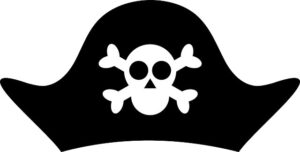
The tricorn hat, firmly established as one of the quintessential pirate symbols, held both practical and symbolic significance. Its wide brim provided protection from the elements, shielding their faces from the scorching sun and torrential rain that plagued their seafaring lives.
But beyond its utilitarian purpose, the tricorn hat served as a visual declaration of their identity, announcing their affiliation with the pirate brethren. With each hat meticulously adorned, pirates embraced a collective image that set them apart from conventional society.
A pirate’s tricorn hat was more than a mere article of clothing; it became an extension of their persona, an emblem of their rebellious ethos. It perched upon their heads as they roamed the vast expanses of the seas, adding an undeniable air of authority and defiance to their presence.
It became a symbol of their willingness to challenge the established order, rejecting the constraints of societal norms and embracing a life of adventure, danger, and camaraderie.
In the annals of history and popular culture, the tricorn hat has come to represent the essence of piracy itself. It has graced the heads of legendary figures such as Blackbeard, Anne Bonny, and Calico Jack, forever etching their names into the fabric of pirate lore.
The tricorn hat, with its timeless allure, serves as a tangible reminder of the captivating world of piracy, captivating imaginations and invoking a sense of fascination even centuries after the Golden Age of Piracy.
Thus, the tricorn hat stands as a testament to the enduring power of pirate symbols, an emblematic accessory that immortalizes the daring exploits and rebellious spirit of those who sailed the high seas in search of adventure and fortune.
It symbolizes the audacity to defy societal conventions, the thrill of embracing a life unbound by the rules of the land, and the camaraderie found among the brethren of the pirate fraternity. The tricorn hat, with its iconic silhouette, forever embodies the allure of piracy, inspiring awe and fascination for generations to come.
6. Eye Patch
The eye patch, a notable pirate symbol, has become an enduring image associated with the swashbuckling pirates of legend. While its origins and prevalence among pirates may be subject to some debate, the eye patch holds a captivating allure within pirate lore. One popular theory suggests that pirates wore eye patches to enhance their night vision.
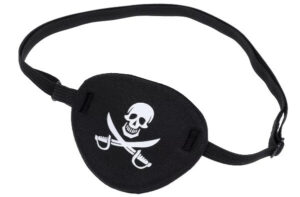
By keeping one eye constantly covered while below deck, they could preserve their vision in low-light conditions and swiftly adapt to sudden changes in light when emerging from the darkness. This practical function allowed pirates to maintain an advantage during nighttime raids or encounters in dimly lit areas of a ship.
Additionally, the eye patch held a symbolic significance. It added an air of mystery and intimidation, as it implied that pirates had faced and overcome dangerous situations, such as battles or injuries, in their seafaring exploits.
The eye patch, thus, became an emblematic accessory, signifying resilience, fearlessness, and the unwavering spirit of those who embraced the pirate way of life.
Its inclusion among pirate symbols evokes visions of daring adventures, fierce battles, and the indomitable spirit of the pirates who fearlessly navigated the treacherous waters of the high seas.
7. Treasure Chest
The treasure chest, a cherished emblem among pirate symbols, evokes the allure of hidden riches and embodies the spirit of adventure that captivates the imaginations of both pirates and enthusiasts of pirate lore. With its weathered wooden exterior and ornate carvings, the treasure chest symbolizes the ultimate quest for wealth and fortune on the high seas.

This iconic pirate symbol serves as a tangible representation of the dreams and aspirations that drove pirates to set sail in search of plunder.
When a pirate stumbled upon a treasure chest, the moment was filled with anticipation and excitement, as the unlocked chest held the promise of unimaginable riches. It became a symbol of triumph, the tangible culmination of their daring exploits.
The treasure chest, standing alongside other beloved pirate symbols, serves as a powerful reminder of the audacity and ambition that defined the pirate way of life. It ignites the desire for adventure and inspires modern-day explorers to delve into the mysteries of the past, in pursuit of hidden treasures that lie waiting to be discovered.
Legacy of Pirate Symbols
Pirate symbols have transcended their historical origins, leaving an indelible mark on contemporary culture. These timeless icons continue to captivate and inspire, resonating with a sense of adventure, rebellion, and the pursuit of freedom.
Pirate symbols have found their way into art, fashion, and branding, becoming iconic motifs that evoke a sense of intrigue and individuality. From vivid paintings to intricate tattoos, pirate symbols adorn various forms of artistic expression, embodying the spirit of exploration and unconventionality.
Additionally, pirate-inspired fashion trends incorporate elements such as skull and crossbones motifs, tricorn hats, and eye patches, providing a bold and edgy aesthetic.
Moreover, businesses and brands have embraced pirate imagery to convey qualities like adventure, resilience, and rebelliousness, captivating audiences with their distinctive visual identity.
Pirate symbols continue to exert a powerful influence on popular culture due to their timeless appeal and ability to ignite the imagination. They represent a yearning for freedom, the allure of the unknown, and the courage to defy societal norms.
Whether it’s through literature, films, or theme park attractions, pirate symbols transport us to a realm where swashbuckling adventures unfold, and the thrill of the high seas beckons. Their enduring presence serves as a reminder of the human desire for exploration, self-expression, and the embrace of individuality.
The widespread usage of pirate symbols in contemporary culture reflects their timeless resonance and universal appeal. By encapsulating the spirit of adventure and the pursuit of personal freedom, pirate symbols continue to inspire people across generations, inviting them to embark on their own journeys of self-discovery and to embrace the daring spirit that pirates embodied.
Shop Handmade Jewelry
Finding the ideal Jewelry can be challenging, especially if you lack inspiration or don’t know where to look.
Surflegacy has you covered. We have a wide range of necklaces and bracelets in various styles, shapes, colors, and materials, to accentuate your fashion look.
Our pieces are crafted in Italy with care and style in mind, reasonably priced, so you won’t have to break the bank to get one. Visit our store and let us assist you on your fashion journey.
